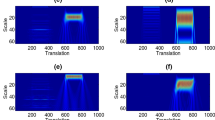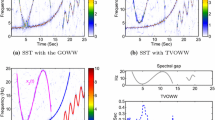Abstract
This paper presents an automatic method of computing a high-resolution adaptive time–frequency distribution. A recently developed locally adaptive directional time–frequency distribution (ADTFD) achieves high energy concentration and cross-term suppression, but it requires manual tuning of certain parameters. One set of parameters is not applicable to all types of signals. Moreover, the ADTFD fails to achieve optimum results when a given signal has both short-duration signal components and close components. This paper overcomes the limitation of the ADTFD by locally adapting the shape of the filter. Experimental results demonstrate the efficacy of the proposed approach for a large class of signals.








Similar content being viewed by others
References
Bastiaans, M., Alieva, T., Stanković, L.: On rotated time–frequency kernels. Signal Process. Lett., IEEE 9(11), 378–381 (2002). doi:10.1109/LSP.2002.805118
Boashash, B., Khan, N.A., Ben-Jabeur, T.: Time–frequency features for pattern recognition using high-resolution tfds. Digit. Signal Process. 40(C), 1–30 (2015)
Iatsenko, D., McClintock, P.V., Stefanovska, A.: Linear and synchrosqueezed time–frequency representations revisited: overview, standards of use, resolution, reconstruction, concentration, and algorithms. Digit. Signal Process. 42, 1–26 (2015). doi:10.1016/j.dsp.2015.03.004
Jones, D., Baraniuk, R.: An adaptive optimal-kernel time–frequency representation. IEEE Trans. Signal Process. 43(10), 2361–2371 (1995)
Khan, N., Boashash, B.: Instantaneous frequency estimation of multicomponent nonstationary signals using multiview time–frequency distributions based on the adaptive fractional spectrogram. Signal Process. Lett., IEEE 20(2), 157–160 (2013)
Khan, N.A., Boashash, B.: Multi-component instantaneous frequency estimation using locally adaptive directional time frequency distributions. Int. J. Adapt. Control Signal Process. (2015). doi:10.1002/acs.2583
Malnar, D., Sucic, V., O’Toole, J.: Automatic quality assessment and optimisation of quadratic time–frequency representations. Electron. Lett. 51(13), 1029–1031 (2015)
Pikula, S.: Verification of enhanced interference reduction in wvd on real non-stationary acoustic signal. In: Carpathian control conference (ICCC), 2015 16th international, pp 385–388 (2015). doi:10.1109/CarpathianCC.2015.7145109
Stanković, L.: A measure of some time–frequency distributions concentration. Signal Process. 81(3), 621–631 (2001). Special section on Digital Signal Processing for Multimedia
Stanković, L., Daković, M., Thayaparan, T.: Time–frequency signal analysis with applications. Artech House Radar. Artech House, Incorporated, Norwood (2013)
Zheng, L., Shi, D., Zhang, J.: Caf-frft: a center-affine-filter with fractional fourier transform to reduce the cross-terms of wigner distribution. Signal Process. 94, 330–338 (2014)
Author information
Authors and Affiliations
Corresponding author
Rights and permissions
About this article
Cite this article
Mohammadi, M., Pouyan, A.A. & Khan, N.A. A highly adaptive directional time–frequency distribution. SIViP 10, 1369–1376 (2016). https://doi.org/10.1007/s11760-016-0901-x
Received:
Revised:
Accepted:
Published:
Issue Date:
DOI: https://doi.org/10.1007/s11760-016-0901-x




